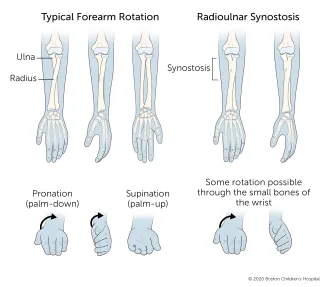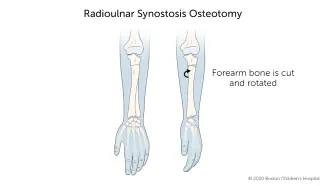Radioulnar Synostosis | Symptoms & Causes
What are the symptoms of congenital radioulnar synostosis?
Congenital radioulnar synostosis can be mild to severe. The telltale symptom is a limitation in your child’s ability to rotate their forearm from a palms-down (pronated) position to a palms-up (supinated) position. A child with radioulnar synostosis may also carry their elbow at an abnormal angle and their forearm may be short or bowed.

In severe cases, the bones are connected and the forearm is fixed in one position, usually with the palm facing down to some degree. Depending on the position of the forearm and the flexibility of your child’s wrist, their activity may be limited in ways that are either subtle or noticeable.
What causes congenital radioulnar synostosis in babies?
A baby’s arms develop between the fifth and eighth week of pregnancy. In the early stages, the radius and ulna bones are connected. These bones later separate and become individual bones. If the radius and ulna do not fully separate, the baby will be born with radioulnar synostosis.
Most cases of congenital radioulnar synostosis happen for no known reason. About one in five children born with the condition have a family history of radioulnar synostosis. It can also be part of an underlying syndrome or developmental abnormality.
Radioulnar Synostosis | Diagnosis & Treatments
How is congenital radioulnar synostosis diagnosed in babies and children?
If your child was born with mild radioulnar synostosis, the condition may not be noticeable and may not be diagnosed until your child reaches school age. In some children, mild radioulnar synostosis is not diagnosed until adolescence.
If your child has a more severe form of the condition, their forearm rotation will be much more limited and the condition will be more obvious. In such cases, the condition can be diagnosed at an earlier age — typically around age 6.
To diagnose radioulnar synostosis, your child’s doctor will do a thorough medical history and physical exam. They may order an X-ray and/or a CT scan. The images will help them assess the underlying structure of your child’s bones, confirm the diagnosis, check for related conditions, and determine a course of treatment.
How is radioulnar synostosis treated in babies and children?
Treatment depends on whether your child is having problems using their arm. Some children with radioulnar synostosis never need surgery. Physical and occupational therapy can help your child meet normal developmental milestones and work around any activity limitations.
If your child has radioulnar synostosis in both arms, or if their forearm is fixed in a position that limits the function of their arm, they may benefit from surgery. Surgery is usually performed before children reach school age.

Surgery involves repositioning the forearm so children can improve the use of the arm. A surgeon will cut the forearm bones, turn them, then secure them in place with plates and pins, a procedure called an osteotomy.
Following surgery, children generally stay in the hospital for one night and wear a cast on their arm for six weeks while their bones heal.
How we care for radioulnar synostosis at Boston Children’s Hospital
The Orthopedics and Sports Medicine Department’s Hand and Orthopedic Upper Extremity Program and our Department of Plastic and Oral Surgery's Hand and Reconstructive Microsurgery Program have treated thousands of babies and children with radioulnar synostosis and other upper extremity issues. We are experienced treating conditions that range from routine to highly complex, and can provide your child with expert diagnosis, treatment, and care. We also offer the benefits of some of the most advanced clinical and scientific research in the world.
Our Orthopedics and Sports Medicine Department is nationally known as the preeminent center for the care of children and young adults with a wide range of developmental, congenital, neuromuscular, sports-related, traumatic, and post-traumatic problems of the musculoskeletal system.
Our Department of Plastic and Oral Surgery is one of the largest and most experienced pediatric plastic and oral surgery centers anywhere in the world. We provide comprehensive care and treatment for a wide variety of congenital and acquired conditions, including hand deformities.


